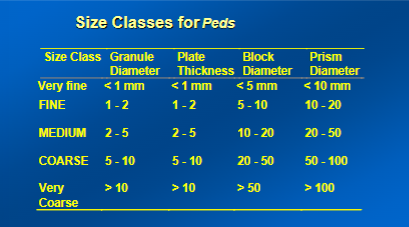Soils Exam 2
1/15
There's no tags or description
Looks like no tags are added yet.
Name | Mastery | Learn | Test | Matching | Spaced |
|---|
No study sessions yet.
16 Terms
The 1° soil particels
Defined on the basis of EFFECTIVE DIAMETER and include sand, silt, and clay.
The three types of soil particles are
Sand, Silt, and Clay
Sand
2 - 0.05 mm diameter
Irregular in size and shape
Primary mineral is quartz (siliceous)
Big pores
Low soil organic matter which means little material holding it together. This leads to high erosion rate
Does not compact well
Silt
0.05 - 0.002 mm diameter
Irregular size and shape
high pH resistance and water holding
Somewhat good compatibility (depending on how much weight there is)
Susceptible to wind and water erosion
Clay
< 0.002mm diameter
< 0.001mm diameter is “colloidal”
Aluminosilicates base = crystalline structure
Fe & Al oxide base = between crystalline to amorphous structure
Slow drainage rate with poor aeration. This causes high water holding capacity
High soil organic matter and fertility
Very compactable
LARGE SURFACE AREA
When soil is aggregated (clumped)
The soil is not susceptible to wind/water erosion
When soil is dispersed (not clumped)
The soil is susceptible to wind/water erosion
Is Poorly Drained soil ALWAYS poorly aerated?
NO. Poorly Drained soil is NOT always poorly aerated
The 2° soil particles
Defined as the aggregation of 1° particles
Soil Structure is characterized by
Shape, Grade, and Size
What are the different shapes of soil?
Granular (porous)
O horizon
Crumb (very porous)
O horizon
Platy
Horizontal plates
Not very porous
B horizon
Angular Blocky
Block shape
Subsoil
Sub-angular blocky
Similar to angular block but not as sharp edges
Columnar
Columns shaped
Found in dry, calcified regions
Prismatic
Vertical orientation
Bx horizon
Example: Fragipan
What are the different grades of soil?
Weak
Poorly formed, in distinct peds, barely observable in place
Moderate
Well formed peds evident in undisturbed soil
Strong
Well formed peds distinct in undisturbed soil
What are the different sizes of soil?
Very Fine
Fine
Medium
Coarse
Very Coarse

Aggregated Formation (Soil Structure Genesis)
Physical Processes
Wetting and drying
Freezing and thawing
Physical effects of roots and other organisms
Aggregated Stability (Soil Structure Genesis)
Soil organic Matter
Microbial decomposition products
root exudates
fungal hyphae exudates (glomalin)
Inorganic Material (interacts with organic material)
Silicate Clay
Fe and Al oxides
Cations (polyvalent = flocculation)
Ex: anything with more than one cation (+2, +3, +4)
Some are monovalent = dispersion (anything with one cation (+1))
Bulk Density (Db)
Mass per unit volume of DRY UNDISTURBED soil